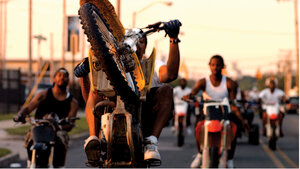'12 O'Clock Boys' takes viewers inside a notorious dirt-bike pack
The documentary directed by Lotfy Nathan follows a young man who wants to join the dirt-bike packs in Baltimore.

Riders in Baltimore’s ‘12 O’Clock Boys’ kick up dust – and sometimes trouble – in the Lotfy Nathan-directed documentary.
Oscilloscope Laboratories
Pug, a smart kid with braided hair and lively eyes, lives with his single mother and siblings on a rundown block in Baltimore. He wants to join the dirt-bike packs that wheel and zoom through the inner city in defiance of the police, who are forbidden to chase them for fear of endangering the public. Instead, law enforcement uses helicopters and tracking technology, creating a brutal and ongoing game of hide-and-seek between the packs and the cops. More than anything, Pug wants entrance into this world.
The documentary “12 O’Clock Boys,” directed by 26-year-old Lotfy Nathan, follows Pug for three years, starting in 2010 when he was 13. We see how he idolizes the bikers, but we also see how little else in his life is worth idolizing. His mother, Coco, a former exotic dancer who has her hands full with her children, is very keen on Pug and hopes that his love for animals will one day encourage him to become a veterinarian. But her maternal ministrations can’t compete with the dirt bikers and their world. (Pug’s father is out of the picture, and his eldest brother, the closest thing to a paternal figure in his life, dies of an asthma attack during filming.)
Nathan follows Pug around with his camera and doesn’t press the boy to explain himself. He’s a remarkably evenhanded filmmaker: During one deadly dispute between the bikers and a cop, he is careful to present both sides, and this approach doesn’t come across as a bland, equal-time balancing act. He genuinely wants all voices to be heard, without editorializing.
We can certainly provide our own interpretations. It’s clear that Pug, who starts out as an innocent of sorts, is by the end more hardened. He is on his way to emulating his heroes – YouTube biker icons such as Wheelie Wayne and Shawn Sean, whom Nathan also interviews. Pug’s language becomes increasingly laced with obscenities, as a kind of badge of honor into the club. He is not unaware of how dangerous dirt-bike riding can be. He doesn’t much care. “Tomorrow is not promised,” he says at the end, matter-of-factly. “I could die tomorrow.”
It’s to Nathan’s credit that he doesn’t negate the allure of dirt-bike riding as an escape hatch from inner-city woes. He films some of the stars in lyrical slow motion. The off-road and ATV vehicles, some of them pitched so far backward that their front wheels shoot straight up (the 12 o’clock position), are amazing camera subjects. What he doesn’t really provide, although it’s implicit in the material, is the attendant violence and drug usage that is also a part of some of these bikers’ lives. We also don’t see enough of Pug away from the streets. I wanted to see more of him in classroom or family settings.
But this objection is, in a way, a tribute to the fascination Pug holds for us. He’s a fiercely individual child, but, inevitably, his predicament also symbolizes how poverty can warp a good boy’s nature. Pug grows up all too fast in “12 O’Clock Boys,” and his growing up is mostly in the wrong direction. He desperately needs tending but the people who care about him are also the ones teaching him how to do wheelies around the police. Grade: B (Unrated.)

